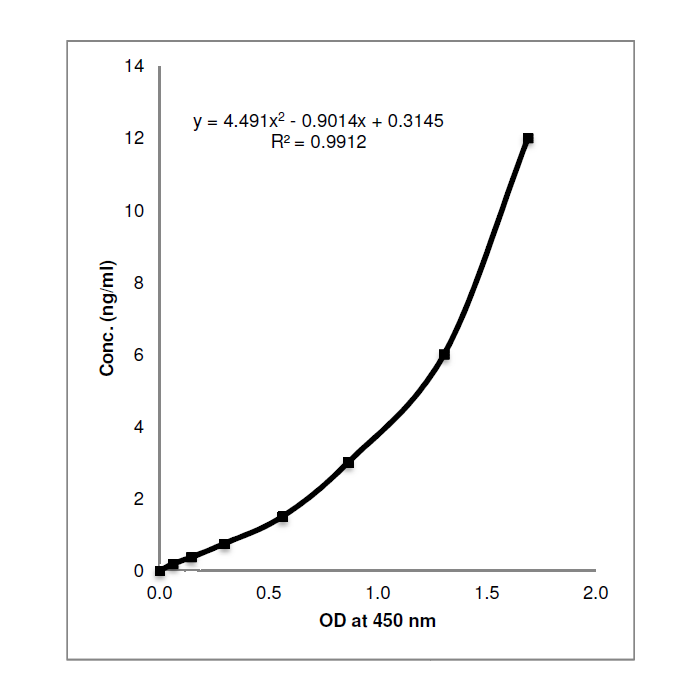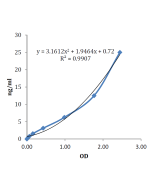Cookie Policy: This site uses cookies to improve your experience. You can find out more about our use of cookies in our Privacy Policy. By continuing to browse this site you agree to our use of cookies.
AdipoGen Life Sciences
RBP4 (mouse/rat) Dual ELISA Kit

| Product Details | |
|---|---|
| Synonyms | Retinol Binding Protein 4 |
| Product Type | Kit |
| Properties | |
| Application Set | Quantitative ELISA |
| Specificity | Detects mouse and rat RBP4. Does not cross-react with human RBP4, mouse adiponectin, mouse resistin, mouse Nampt, rat adiponectin, rat resistin or rat Nampt. |
| Crossreactivity |
Mouse Rat |
| Quantity | 1 x 96 wells |
| Sensitivity | 60pg/ml |
| Range | 0.188 to 12ng/ml |
| Sample Type |
Cell Culture Supernatant Serum Urine |
| Assay Type | Sandwich |
| Detection Type | Colorimetric |
| Shipping and Handling | |
| Shipping | BLUE ICE |
| Short Term Storage | +4°C |
| Long Term Storage | +4°C |
| Handling Advice |
After standard reconstitution, prepare aliquots and store at -20°C. Avoid freeze/thaw cycles. Plate and reagents should reach room temperature before use. |
| Documents | |
| Manual |
 Download PDF Download PDF |
| MSDS |
 Download PDF Download PDF |
| Product Specification Sheet | |
| Datasheet |
 Download PDF Download PDF |
Retinol binding protein 4 (RBP4; RBP) is a 21kDa secreted protein, a member of the lipocalin family and is known as the primary transporter of retinol (vitamin A) to tissues. A recent report revealed RBP4 as an adipokine linking glucose transporter 4 (GLUT4) suppression in adipose tissue to insulin. Elevated human and mouse serum RBP4 levels are associated with insulin resistance and its severity, obesity and certain components of metabolic syndrome. Furthermore, human serum RBP4 levels are closely related to renal function and recent studies have shown an association between serum RBP4 levels and urinary albumin excretion. The urinary RBP4 concentration may be a valuable marker for both, insulin resistance and microalbuminuria in insulin-resistant subjects.
- Plasma retinol-binding protein-4 concentrations are elevated in human subjects with impaired glucose tolerance and type 2 diabetes: Y.M. Cho, et al.; Diabetes Care 29, 2457 (2006)
- High circulating retinol-binding protein 4 is associated with elevated liver fat but not with total, subcutaneous, visceral, or intramyocellular fat in humans: N. Stefan, et al.; Diabetes Care 30, 1173 (2007)
- Cyanidin 3-glucoside ameliorates hyperglycemia and insulin sensitivity due to downregulation of retinol binding protein 4 expression in diabetic mice: R. Sasaki, et al.; Biochem. Pharmacol. 74, 1619 (2007)
- Decreased clearance of serum retinol-binding protein and elevated levels of transthyretin in insulin-resistant ob/ob mice: N. Mody, et al.; Am. J. Physiol. Endocrinol. Metab. 294, E785 (2008)
- Identification and characterization of a non-retinoid ligand for retinolbinding protein 4 which lowers serum retinol-binding protein 4 levels in vivo: A. Motani, et al.; J. Biol. Chem. 284, 7673 (2009)
- Effect of dietary monosodium glutamate on trans fat-induced nonalcoholic fatty liver disease: K.S. Collison, et al.; J. Lipid Res. 50, 1521 (2009)
- Diabetes of the Liver: The Link Between nonalcoholic fatty liver disease and HFCS-55: K.S. Collison, et al.; Obesity 17, 2003 (2009)
- Early postnatal oestradiol exposure causes insulin resistance and signs of inflammation in circulation and skeletal muscle: C. Alexanderson, et al.; J. Endocrinol. 201, 49 (2009)
- Dietary trans-fat combined with monosodium glutamate induces dyslipidemia and impairs spatial memory: K.S. Collison, et al.; Physiol. Behav. 99, 334 (2010)
- Effect of dietary monosodium glutamate on HFCS-induced hepatic steatosis: expression profiles in the liver and visceral fat: K.S. Collison, et al.; Obesity (Silver Spring) 18, 1122 (2010)
- Dietary anthocyanin-rich bilberry extract ameliorates hyperglycemia and insulin sensitivity via activation of AMP-activated protein kinase in diabetic mice: M. Takikawa, et al.; J. Nutr. 140, 527 (2010)
- Increased lipid accumulation in liver and white adipose tissue in aging in the SAMP10 mouse: T. Honma, et al.; J. Nutr. Sci. Vitaminol. (Tokyo) 57, 123 (2011)
- Elevated retinol binding protein 4 contributes to insulin resistance in spontaneously hypertensive rats: H.Y. Ou, et al.; Horm. Metab. Res. 43, 312 (2011)
- Suppression of retinol-binding protein 4 with RNA oligonucleotide prevents high-fat diet-induced metabolic syndrome and non-alcoholic fatty liver disease in mice: Y. Tan, et al.; Biochim. Biophys. Acta 1811, 1045 (2011)
- Effects of hesperidin on the progression of hypercholesterolemia and fatty liver induced by high-cholesterol diet in rats: X. Wang, et al.; J. Pharmacol. Sci. 117, 129 (2011)
- Peroxisome Proliferator-Activated Receptors-α and -γ, and cAMP-Mediated Pathways, Control Retinol-Binding Protein-4 Gene Expression in Brown Adipose Tissue: M. Rosell, et al.; Endocrinol. 153, 1162 (2012)
- Caffeic Acid Phenylethyl Amide Protects against the Metabolic Consequences in Diabetes Mellitus Induced by Diet and Streptozocin: Y.C. Weng, et al.; Evid. Based Complement. Alternat. Med. 2012, ID 984780 (2012)
- Blueberry polyphenol-enriched soybean flour reduces hyperglycemia, body weight gain and serum cholesterol in mice: D.E. Roopchand, et al.; Pharmacol. Res. 68, 59 (2012)
- Evaluation of the relative performance of 12 urinary biomarkers for renal safety across 22 rat sensitivity and specificity studies: K. Vlasakova, et al.; Toxicol. Sci. 138, 3 (2013)
- Association of urinary RBP4 with insulin resistance, inflammation, and microalbuminuria: S.E. Park, et al.; Eur. J. Endocrin. 171, 443 (2014)
- Hepatocytes are the principal source of circulating RBP4 in mice: S.J. Thompson, et al.; Diabetes 66, 58 (2017)






